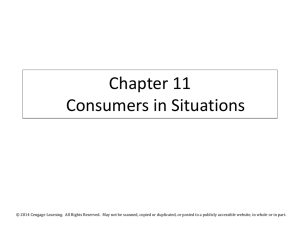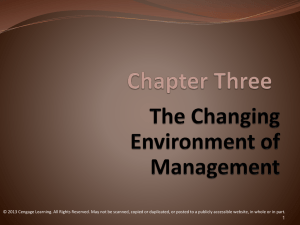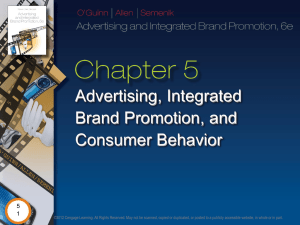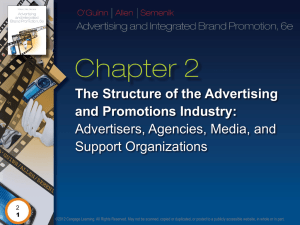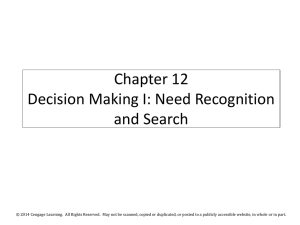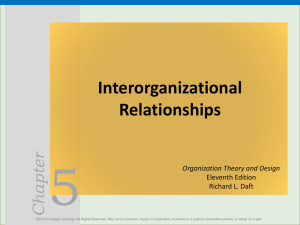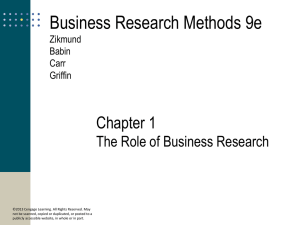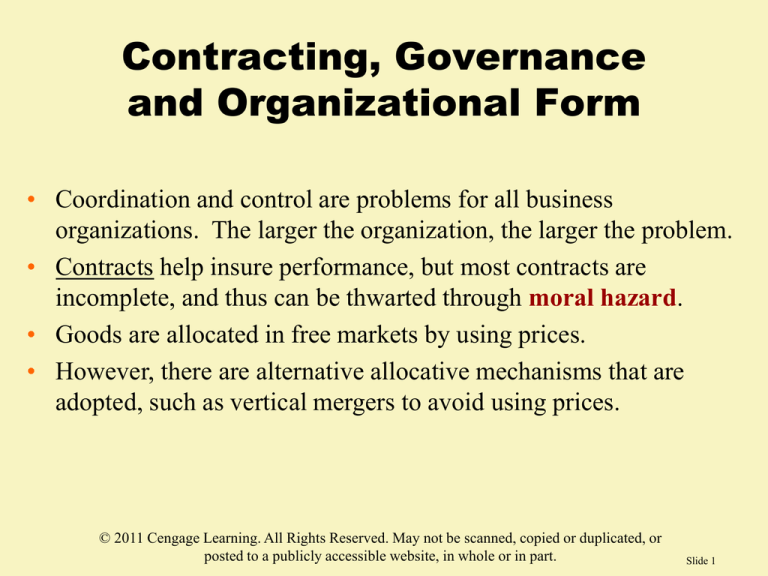
Contracting, Governance
and Organizational Form
• Coordination and control are problems for all business
organizations. The larger the organization, the larger the problem.
• Contracts help insure performance, but most contracts are
incomplete, and thus can be thwarted through moral hazard.
• Goods are allocated in free markets by using prices.
• However, there are alternative allocative mechanisms that are
adopted, such as vertical mergers to avoid using prices.
© 2011 Cengage Learning. All Rights Reserved. May not be scanned, copied or duplicated, or
posted to a publicly accessible website, in whole or in part.
Slide 1
Role of Business Contracting in
Cooperative Games
• The amount of advertising and service can be
viewed as a game.
• The outcome can be sub-optimal; that is, it is not
value maximizing. The cooperative solution
sometime yields better payoffs.
• To get to a value-maximizing solution, the
manufacturer may have to consider side
payments or credible commitments to the
retailer.
© 2011 Cengage Learning. All Rights Reserved. May not be scanned, copied or duplicated, or
posted to a publicly accessible website, in whole or in part.
Slide 2
© 2011 Cengage Learning. All Rights Reserved. May not be scanned, copied or duplicated, or
posted to a publicly accessible website, in whole or in part.
Slide 3
Contracts
• Contracts between players are binding, they specify
actions by both parties.
» A contract is a third party enforceable agreement to
facilitate deferred exchange.
• Contracts must assign penalties for not living up to the
agreement. These payments are part of a several step
sequential game.
» If the retailer decides to discontinue a service for a
product the manufacturer produces, then the contract
can provide economic sanctions that make this
decision unattractive.
© 2011 Cengage Learning. All Rights Reserved. May not be scanned, copied or duplicated, or
posted to a publicly accessible website, in whole or in part.
Slide 4
Vertical Requirements Contract
• A vertical requirements contract is one in which the
firms in successive stages of production agree to
payments and/or penalties for taking an action.
• Contracts must assign penalties for not living up to
the agreement. These payments are part of a several
step sequential game.
» If the manufacturer spends a large amount to advertise
the product, the distributor promises to promote the
product as well.
© 2011 Cengage Learning. All Rights Reserved. May not be scanned, copied or duplicated, or
posted to a publicly accessible website, in whole or in part.
Slide 5
Vertical Requirements Contract
• Expectation damages are remedies for breach of contract
designed to elicit efficient precaution and efficient reliance on
promises. These are payments for non-performance of a
contract.
© 2011 Cengage Learning. All Rights Reserved. May not be scanned, copied or duplicated, or
posted to a publicly accessible website, in whole or in part.
Slide 6
Frustration of Purpose
Doctrine
• Suppose you enter into an agreement to sell a
truck that uses 100% ethanol. But suppose the
government changes rules making ethanol use
prohibited.
• The Uniform Commercial Code (UCC) provided
the frustration of purpose doctrine to excuse the
truck manufacturer from delivering something it is
prohibited in doing. This would likely give the
truck manufacturer a way to avoid ‘expectation
damages’ if sued by the truck retailer.
© 2011 Cengage Learning. All Rights Reserved. May not be scanned, copied or duplicated, or
posted to a publicly accessible website, in whole or in part.
Slide 7
A Spectrum of Contract
Environments
• Spot Market Transaction – one time only exchange of
standardized goods
» Tends to be between anonymous buyers and sellers, and
information tends to be efficient
» The purchase of a dozen ears of corn at a roadside stand or the sale
of electricity at a spot rate off the grid, are examples of spot
markets.
• Vertical Requirements Contracts – promise of future
performance for immediate consideration
» Tends to be between contract partners that know each other, but
there are problems with ambiguity
© 2011 Cengage Learning. All Rights Reserved. May not be scanned, copied or duplicated, or
posted to a publicly accessible website, in whole or in part.
Slide 8
A Spectrum of Contract
Environments
• Relational Contract – between repeat business parties
» Tends to be self-enforcing because we can see if the other partner
lives up to his or her word.
© 2011 Cengage Learning. All Rights Reserved. May not be scanned, copied or duplicated, or
posted to a publicly accessible website, in whole or in part.
Slide 9
Incomplete Information and
Incomplete Contracting
• Incomplete Information -- uncertain
knowledge of payoffs, choices, or types of
opponents a market player faces.
• Insurance works when we can pool a group of
possible events (like injuries at work) to
reduce the risk of loss to any one party.
© 2011 Cengage Learning. All Rights Reserved. May not be scanned, copied or duplicated, or
posted to a publicly accessible website, in whole or in part.
Slide 10
Incomplete Information and
Incomplete Contracting
• But some risks are catastrophic, like a
nuclear accident. It is difficult to assess the
likelihood or the damage; hence, insurance in
this case is often unavailable.
• Contracts can specify duties under several
states of the world, but sometimes the
outcomes are too numerous or unknowable for
years. This creates incomplete contracts.
© 2011 Cengage Learning. All Rights Reserved. May not be scanned, copied or duplicated, or
posted to a publicly accessible website, in whole or in part.
Slide 11
Types
• Full contingent claims contract -- specifies all
possible future events.
• Incomplete contingent claims contract -- not
all possible future events are specified. Due to
incomplete contracts, some people may take
advantage of the spirit of the contract.
Accident insurance may permit people to succumb
to a moral hazard by acting recklessly.
© 2011 Cengage Learning. All Rights Reserved. May not be scanned, copied or duplicated, or
posted to a publicly accessible website, in whole or in part.
Slide 12
Corporate Governance and the
Problem of Moral Hazard
• Doing business in markets involves the cost of contracts.
• When only incomplete contracts are possible, it is often the
best to integrate the operations within a firm.
• The moral hazard problem occurs when parties change their
behavior due to contracts. This is especially true when the
people’s effort is hard to observe.
© 2011 Cengage Learning. All Rights Reserved. May not be scanned, copied or duplicated, or
posted to a publicly accessible website, in whole or in part.
Slide 13
Corporate Governance and the
Problem of Moral Hazard
• In a borrower-lender contract, a reliable borrower, once given
money in a loan, may elect to invest in highly risky projects.
•
» To try to avoid this moral hazard, the bank may insist on
costly monitoring or governance actions, forcing the
borrower to submit frequent financial data.
© 2011 Cengage Learning. All Rights Reserved. May not be scanned, copied or duplicated, or
posted to a publicly accessible website, in whole or in part.
Slide 14
Implementaion of Mechanisms of
Corporate Governance
Table 15.2
• Internal monitoring by an independent board of
directors subcommittee
• Internal/external monitoring by large creditors
• Internal/external monitoring by owners of large
blocks of stock
• Auditing and variance analysis
• Internal benchmarking
• Corporate culture of ethical duties
• High employee morale supportive of whistle
blowers
© 2011 Cengage Learning. All Rights Reserved. May not be scanned, copied or duplicated, or
posted to a publicly accessible website, in whole or in part.
Slide 15
The Principal-Agent Model
• The agents (managers) may wish to maximize leisure
and minimize risk, whereas the principal
(shareholders) may wish hard work and high riskreturn investments.
• Example: an employee knows that working hard helps
the whole firm, and helps himself only a little. Why
not let the other workers be grinds and take it easy (be
a free rider)?
© 2011 Cengage Learning. All Rights Reserved. May not be scanned, copied or duplicated, or
posted to a publicly accessible website, in whole or in part.
Slide 16
The Principal-Agent Model
• Principal-Agent problems may lead to:
• Risk Avoidance in Managers
• Managers have Short Time Horizons
• Sales Maximization
• High Levels of Social Amenities at the Work Site
• Satisficing or Sufficing Behavior
© 2011 Cengage Learning. All Rights Reserved. May not be scanned, copied or duplicated, or
posted to a publicly accessible website, in whole or in part.
Slide 17
Alternative Managerial Labor Contracts
• A consultant is hired for 50 hours at Wa.
• Alternatively, a manager is paid a profit-sharing payment, ray AB, which is
40% of the profits
» The first 22 hours, the consultant is overcompensated area AJD
» The last 28 hours, consultant is under-compensated area DCF
» If Area O = Area U, the consultant is indifferent between fixed wage Wa
and the 40% profit sharing deal
• If profit sharing were reduced, to IB, then the consultant would prefer the fixed
wage rate.
© 2011 Cengage Learning. All Rights Reserved. May not be scanned, copied or duplicated, or
posted to a publicly accessible website, in whole or in part.
Slide 18
Work Effort, Creative Ingenuity, and
the Moral Hazard Problem
• Profit sharing, in the previous example, has a
problem.
• After the first 22 hours, if the work is not
observed, the consultant can earn Wa, at other
work.
• It is disloyal, but rational not to work as hard
as possible for this employer.
© 2011 Cengage Learning. All Rights Reserved. May not be scanned, copied or duplicated, or
posted to a publicly accessible website, in whole or in part.
Slide 19
Work Effort, Creative Ingenuity, and
the Moral Hazard Problem
• The shirking consultant works for two
employers.
• With this outcome expected by the employer,
the employer decides against offering a profitsharing contract, and if possible, attempts to
monitor the consultant by a piece rate.
© 2011 Cengage Learning. All Rights Reserved. May not be scanned, copied or duplicated, or
posted to a publicly accessible website, in whole or in part.
Slide 20
Principal-Agent Problem
in Managerial Labor Markets
• Stockholders (principals) hire managers
(agents) with different incentives.
• Alternative labor contracts
Pay based on profits
Paying a bonus on top of a salary when goals are
exceeded
Have manager own stock
• Benchmarking involves a comparison of similar firms,
plants, or divisions
© 2011 Cengage Learning. All Rights Reserved. May not be scanned, copied or duplicated, or
posted to a publicly accessible website, in whole or in part.
Slide 21
Signaling and Sorting of Managerial
Talent
Applicants
to positions know more about themselves
than they reveal, which is the problem of asymmetric
information.
Asymmetric Information -- unequal or dissimilar
knowledge among market participants.
For example, is the applicant highly risk averse or a
risk taker?
If I ask you if you are highly risk averse, you will likely tell
me what I want to hear.
How
can we sort between risk-takers and risk averse
candidates?
© 2011 Cengage Learning. All Rights Reserved. May not be scanned, copied or duplicated, or
posted to a publicly accessible website, in whole or in part.
Slide 22
Screening and Sorting of Managerial Talent
with Optimal Incentives Contracts
• A Linear Incentive Contract is a combination of salary
and (plus or minus!) a profit sharing rate.
• A Pooling Equilibrium is an offer that dominates all other
offers will not help distinguish among applicants.
• A Separating equilibrium is an offers that distinguishes
between behaviors
• For example, a risk averse person would tend to select an
offer which primarily paid a base salary
• Whereas the risk-loving individual would tend to select an
offer with more profit sharing.
© 2011 Cengage Learning. All Rights Reserved. May not be scanned, copied or duplicated, or
posted to a publicly accessible website, in whole or in part.
Slide 23
© 2011 Cengage Learning. All Rights Reserved. May not be scanned, copied or duplicated, or
posted to a publicly accessible website, in whole or in part.
Slide 24
Choosing the Efficient Organizational Form
• A reliant asset is at least partially non-redeployable durable asset.
» Specialized equipment or specialized knowledge cannot be
transferred to other uses.
• In markets with reliant assets, one party could “hold-up” the other
party. The choice of organization will require explicit contracts.
• The likely outcome is franchise contracts or vertical integration.
• Relational contracts are promissory agreements of coordinated
performance.
» Pepsi selling Starbucks cold frappuccino in Pepsi vending
machines is a relational contract or alliance agreement.
© 2011 Cengage Learning. All Rights Reserved. May not be scanned, copied or duplicated, or
posted to a publicly accessible website, in whole or in part.
Slide 25
The Efficient Organizational Form Depends
on Asset Characteristics
Table 15.3
Fully Redeployable
Durable Assets
Nonredeployable
Reliant Assets
Not Dependent on
Unique
Complements
Spot market
recontracting
One-Way
Dependent Assets
Relational contracts
(alliances)
Long-term supply
contracts +
risk management
Vertical integration
Bilateral Dependent
Assets
Relational contracts
(joint ventures)
Fixed profit-sharing
contracts
© 2011 Cengage Learning. All Rights Reserved. May not be scanned, copied or duplicated, or
posted to a publicly accessible website, in whole or in part.
Slide 26
Prospect Theory
Motivates Full-Line Forcing
• Utility theory in economics is based on the LEVEL of
wealth or income received. More money leads to higher
satisfaction or utility.
• But Prospect theory is based on the choice relative to a
base point. The difference (or the prospect) is categorized
as either a gain or loss.
© 2011 Cengage Learning. All Rights Reserved. May not be scanned, copied or duplicated, or
posted to a publicly accessible website, in whole or in part.
Slide 27
Prospect Theory
Motivates Full-Line Forcing
• Buy now, pay later has both a gain (the goods now) and
the loss (the pay later)
• A car purchase as a “loss” of the money paid, but as a
“gain” if you think you got a good deal. It can also help
explain why manufacturers offer many versions (a fullline) of automobiles to get the customer to trade up to a
pricier version.
© 2011 Cengage Learning. All Rights Reserved. May not be scanned, copied or duplicated, or
posted to a publicly accessible website, in whole or in part.
Slide 28
Prospect Theory & Full-Line Forcing
© 2011 Cengage Learning. All Rights Reserved. May not be scanned, copied or duplicated, or
posted to a publicly accessible website, in whole or in part.
Slide 29
Vertical Integration
• Vertical integration is a way to avoid transaction
costs, such as moral hazard, which are found in
arm's length (or market) dealing.
• The two stages of production are merged. The
producer ships goods to the next stage of the same
firm.
• If each stage of production has some monopoly
power, the profits can be higher by merging the two
stages.
© 2011 Cengage Learning. All Rights Reserved. May not be scanned, copied or duplicated, or
posted to a publicly accessible website, in whole or in part.
Slide 30
Vertical Integration in the Hosiery Market
Ph’
Ph
Py’
Py
• Suppose yarn is used in
making hosiery (socks) in
fixed proportions.
• Let the marginal cost of
yarn (MCy) and hosiery
Py’ +MCh
manufacture (MCh) be
constant.
MCy +MCh
• The profit maximizing
hosiery price is Ph
MCh
• But if the price of yarn is
raised to Py’ the price ends
Higher yarn prices
up too high at Ph’ with
MCy
smaller total profits for the
MRh
hosiery + yarn industries.
DEMAND
Figure 15.6
Quantity (lbs.)
© 2011 Cengage Learning. All Rights Reserved. May not be scanned, copied or duplicated, or
posted to a publicly accessible website, in whole or in part.
Slide 31
Mergers with
Upstream Competitors
• Hence, if one firm manufactured yarn and another
firm manufacturer hosiery, the merged firm could
be run optimally and be more profitable than
separate firms.
• This is a reason why firms often expand vertically
(or backward to earlier stages of production).
» If the hosiery firm buys a yarn maker, this is viewed as
backward integration, going backward “upstream” in
the manufacturing process.
© 2011 Cengage Learning. All Rights Reserved. May not be scanned, copied or duplicated, or
posted to a publicly accessible website, in whole or in part.
Slide 32
Dissolution
• Integration combines assets, but often conglomerate
firms find it in their interest to sell assets to get back to
their core businesses.
• Suppose a partnership wants to divide up the assets, but
in doing so, the market may wish only to pay highly
discounted prices.
© 2011 Cengage Learning. All Rights Reserved. May not be scanned, copied or duplicated, or
posted to a publicly accessible website, in whole or in part.
Slide 33
Dissolution
• Suppose the whole firm is worth $3 million, and Joe
and Kim want to divide it.
• If both agree, the deal goes through.
• If either disagrees, the value of the whole shrinks by $1
million at EACH disagreement. What happens?
© 2011 Cengage Learning. All Rights Reserved. May not be scanned, copied or duplicated, or
posted to a publicly accessible website, in whole or in part.
Slide 34
© 2011 Cengage Learning. All Rights Reserved. May not be scanned, copied or duplicated, or
posted to a publicly accessible website, in whole or in part.
Slide 35
Government Regulation
• Corporations are legal entities which exist only
because governments allow them to exist.
• Governments impose many restrictions on
firms: mergers, patents, licensing, or subsidies.
• The stated intention of governments is to set
restrictions that promote social welfare, but
they sometimes benefit particular groups or
individuals.
© 2011 Cengage Learning. All Rights Reserved. May not be scanned, copied or duplicated, or
posted to a publicly accessible website, in whole or in part.
Slide 36
© 2011 Cengage Learning. All Rights Reserved. May not be scanned, copied or duplicated, or
posted to a publicly accessible website, in whole or in part.
Slide 37
© 2011 Cengage Learning. All Rights Reserved. May not be scanned, copied or duplicated, or
posted to a publicly accessible website, in whole or in part.
Slide 38
Antitrust Regulation and
their Enforcement
• In trusts, the voting rights to the several
firms are conveyed to a legal trust to
manage the group of firms as if it were one
firm. This tends to create monopolization
of an industry.
• The Sherman Antitrust Act (1890)
outlawed monopolies per se and attempted
monopolization.
© 2011 Cengage Learning. All Rights Reserved. May not be scanned, copied or duplicated, or
posted to a publicly accessible website, in whole or in part.
Slide 39
The Clayton Act (1914)
• The Clayton Act (1914) extended the list of
conduct that was anti-competitive:
a. price discrimination. (section 2)
b. tying contracts force customers to buy
added products with one product. (section 3)
c. purchasing shares of competing firms as an
anti-merger section. (section 7)
d. corporate directorship interlocks occur
when the same people are in
directorships of competing firms. (section 8)
© 2011 Cengage Learning. All Rights Reserved. May not be scanned, copied or duplicated, or
posted to a publicly accessible website, in whole or in part.
Slide 40
The Federal Trade Commission
Act (1914)
• Was passed in 1914 as a supplement to
the Clayton Act.
• Section 5 states “..unfair methods of
competition in commerce are hereby
declared illegal.”
© 2011 Cengage Learning. All Rights Reserved. May not be scanned, copied or duplicated, or
posted to a publicly accessible website, in whole or in part.
Slide 41
Robinson-Patman Act (1936)
Section 2(a) prohibits price discrimination which
"substantially lessen competition".
Section (2b) provides a cost justification for price
discrimination.
Section (2c) prohibits some kinds of brokerage
commissions.
Sections (2d-2e) prohibits discounts to buyers not
afforded to other customers.
© 2011 Cengage Learning. All Rights Reserved. May not be scanned, copied or duplicated, or
posted to a publicly accessible website, in whole or in part.
Slide 42
Hart-Scott-Rodino Antitrust
Improvement Act (1976)
• Requires notification by large firms to the Justice
Department and FTC of impending mergers.
• DOJ and/or FTC may either challenge the proposed
merger or allow the merger to be completed.
© 2011 Cengage Learning. All Rights Reserved. May not be scanned, copied or duplicated, or
posted to a publicly accessible website, in whole or in part.
Slide 43
Measuring the impact of mergers
• A relevant market is a group of economic agents
that interact in a buyer-seller relationship. The
nature of that relationship is affected by the
number and size distribution of the buyers and
sellers.
• A popular measure of seller concentration is the
percentage of an industry comprised of the top 4
firms (4CR).
• Similarly, the top 4 buyers is a popular measure
of buyer concentration.
© 2011 Cengage Learning. All Rights Reserved. May not be scanned, copied or duplicated, or
posted to a publicly accessible website, in whole or in part.
Slide 44
Market Concentration Ratios
• The size distribution of firms is measured by the percentage of
the top four (4CR) firms (or buyers)
» .22
» .18
58% of market is controlled by top 4 firms
» .10
» .08
» … shares of market listed in descending order
• Similar concentration of occur for 8-firm, 20-firm, and 50-firm
ratios
© 2011 Cengage Learning. All Rights Reserved. May not be scanned, copied or duplicated, or
posted to a publicly accessible website, in whole or in part.
Slide 45
Herfindahl-Hirschman Index (HHI)
• To compute HHI:
» You must know the market shares of all firms
» Herfindahl-Hirschman Index:
HHI = S si2
» The larger the HHI the more monopolistic is the industry
• Example: Baby Food
» 70% for Gerber
» 16% for Beech-Nut
» 14% for Heinz
• So the 4CR = 100%
• And the HHI = (70)2 + (16)2 + (14)2 = 5,352
• The maximum HHI is (100)2 = 10,000 for a pure monopoly
• With 100 firms, each with 1% of the market, HHI=100
© 2011 Cengage Learning. All Rights Reserved. May not be scanned, copied or duplicated, or
posted to a publicly accessible website, in whole or in part.
Slide 46
Antitrust Prohibitions
of Selected Business Decisions
Collusion to fix prices (airlines and grocery
stores have been penalized)
Mergers that substantially lessen competition
(mergers raise 4CR and the HHI)
» If HHI > 1,800, mergers are usually challenged
» If 1,000 < HHI < 1,8000, mergers tend to be
challenged if raise the HHI by more than 100 points
» If HHI < 1,000, most mergers are not challenged
• 4CR and HHI are two ways to measure changes
in market structure caused by mergers.
© 2011 Cengage Learning. All Rights Reserved. May not be scanned, copied or duplicated, or
posted to a publicly accessible website, in whole or in part.
Slide 47
Merger of DISH Network &
Direct TV is Disapproved
•
•
DISH Network and Direct TV were not permitted to merge.
Market shares of the competitors before merger were
1.
2.
3.
4.
5.
6.
•
Comcast
33%
DIRECTV
17%
Time Warner 17%
DISH Network 13%
Charter Comm. 10%
Cox Comm.
10%
HHI
2,036
The relevant market was defined to be satellite TV, and the
proposed merger increased the HHI by 442 points, which led
the Antitrust Division of the Justice Department to disallow the
merger
© 2011 Cengage Learning. All Rights Reserved. May not be scanned, copied or duplicated, or
posted to a publicly accessible website, in whole or in part.
Slide 48
More Antitrust Prohibitions:
Monopolization (attempted
monopolization is a violation of the
Sherman Antitrust Act)
Wholesale Price Discrimination (forms
of price discrimination that injured other
competitors, not necessarily customers)
» Penguin Books sold books at lower prices to
Barnes & Noble than to other bookstores
Refusals to Deal (when not based on
legitimate business justifications)
© 2011 Cengage Learning. All Rights Reserved. May not be scanned, copied or duplicated, or
posted to a publicly accessible website, in whole or in part.
Slide 49
The Deregulation Movement
• Airlines and the trucking industries
have been deregulated.
• They are no longer "infant industries".
• Deregulation of long-distance occurred
due in large part to technological
changes in transmitting phone
messages by microwave.
© 2011 Cengage Learning. All Rights Reserved. May not be scanned, copied or duplicated, or
posted to a publicly accessible website, in whole or in part.
Slide 50
Regulation of Externalities
• Externalities:
» Externalities exist when benefits or costs fall on others who do not
contribute or are reimbursed.
» Some externalities are welcome and others are disliked.
• Pecuniary Externalities:
» When the spillover are purely reflected in prices
» Example: The fear of mad cow disease reduces beef prices and raises
chicken prices, but no inefficiency occurs as they are reflected in market
prices.
• Resource Misallocation:
» When not pecuniary, externalities harm resource allocation. Urban blight
leads to too little investment.
© 2011 Cengage Learning. All Rights Reserved. May not be scanned, copied or duplicated, or
posted to a publicly accessible website, in whole or in part.
2005 South-Western Publishing
Slide 51
The Coase Theorem
The Coase Theorem argues that, if the transaction
costs for private contracting between parties are
very low, the problems of externalities will be
resolved without governmental intervention
efficiently.
Even if governments and the courts can assign
property rights or duties however they wish, the
solution is unaffected when transaction costs are
low.
Consider a railroad that burns crops planted nearby.
© 2011 Cengage Learning. All Rights Reserved. May not be scanned, copied or duplicated, or
posted to a publicly accessible website, in whole or in part.
Slide 52
Coase’s Railroad
• Table 16.4 panel A, when the RR has property rights. Farmer’s profits in
the upper triangle. Without contracting, the RR would run 2 trains per day
and the Farmer would plant 10 acres.
• With contracting, Coase predicts that farmer would bribe the RR about
$501 to reduce the number of trains to 1 per day. The farmer gets $900 $401 = $499 which is better $300; RR gets $1,501 better than $1,500.
Farmer’s Gross Profits
By acres planted
0
10
0
0
0
1,500
0
0
Railroad’s 1
Gross Profits
1,000
By trains per day
1,600
0
900
1,000
0
2
20
400
1,000
300
-800
© 2011 Cengage Learning. All Rights Reserved. May not be scanned, copied or duplicated, or
posted to a publicly accessible website, in whole or in part.
1,500
1,500
1,500
Slide 53
Coase’s Railroad
• Table 16.4 panel B, when the RR has the liabilities. Without
contracting, the Farmer would plant 20 acres & the RR would not run.
• With contracting, Coase predicts that RR would bribe the RR about
$101 to reduce the acreage to 10. The farmer gets $1,500 + $101 =
$1,601 which is better $1,600; RR gets $400 - $101 better than without
contracting.
Farmer’s Gross Profits
By acres planted
0
10
0
0
0
1,500
0
0
Railroad’s 1
Gross Profits
1,000
By trains per day
1,600
0
1,500
400
0
2
20
1,600
-200
300
1,600
© 2011 Cengage Learning. All Rights Reserved. May not be scanned, copied or duplicated, or
posted to a publicly accessible website, in whole or in part.
1,500
300
-900
Slide 54
Result of Coase’s
Railroad Example
• Whether the RR had the property right or the farmer, the result
was 10 acres and 1 train per day. Circled in both examples.
• This required a very low cost of contracting.
• This is called Reciprocal Externalities.
• We might expect that there would be many farmers and the costs
of transactions could be steep.
» Class Action Suits – is a way to reduce the costs of a group
» Strategic Holdouts – can raise the cost of negotiation if one
farmer wants even more of the payout
© 2011 Cengage Learning. All Rights Reserved. May not be scanned, copied or duplicated, or
posted to a publicly accessible website, in whole or in part.
Slide 55
Coase Theorem with Farmers & Ranchers:
• Cattle Ranchers
another example
» Suppose a fence costs
$500,000 to keep cattle
out of farmland
» Suppose damage to
corn is $100,000 by
cattle
» What should happen?
• No fence will be built
• Corn Farmers
» Now suppose that a
fence costs only
$100,000
» Suppose damage to
corn is $500,000 by
the cattle
» What should happen?
• A fence will be built
© 2011 Cengage Learning. All Rights Reserved. May not be scanned, copied or duplicated, or
posted to a publicly accessible website, in whole or in part.
Slide 56
But Property Rights Matter
in a world with transaction costs
• It is often costly to arrange contracts between
ranchers and farmers
• Suppose the fence costs more than the damage
» If the property right to safe crops is established, the
farmer will want a fence regardless of cost. An
costly fence is constructed.
» If the property right is for open range grazing, the
rancher will not want a fence. No fence is built.
• Therefore, who gets the property right matters!
© 2011 Cengage Learning. All Rights Reserved. May not be scanned, copied or duplicated, or
posted to a publicly accessible website, in whole or in part.
Slide 57
Other Solutions to
Externalities
•
•
•
•
•
Solution by Prohibition.
Solution by Regulatory Directive.
Solution by Taxes and Subsidies.
Solution by Sale of Pollution Rights.
Solution by Merger
© 2011 Cengage Learning. All Rights Reserved. May not be scanned, copied or duplicated, or
posted to a publicly accessible website, in whole or in part.
Slide 58
Government
Protection of Business
• Governments historically have helped some companies by
restricting or eliminating competition.
• Examples
» Licensing of professions (or businesses)
» Permission to run a business in a community
» Patents of ideas or processes restricts
use of
the idea
» Import quotas
© 2011 Cengage Learning. All Rights Reserved. May not be scanned, copied or duplicated, or
posted to a publicly accessible website, in whole or in part.
Slide 59
Debate on Patent Protection
•
•
•
How long should a patent run?
20 years in US may be too long
But patents reward R&D work
Consider: Motorola & Lucent who can come up with
a patent or imitate (copy) the other firm’s idea
Motorola’s payoffs are in the upper triangles.
» Strategy choices: Patent means develop and
patent. Imitate means imitate by licensing.
If Motorola develops a process and patents it, Lucent
will imitate and license it, so Motorola will see this as
a poor outcome.
If Lucent develops a process and patents it, it is best
for Motorola to imitate with a license.
» This outcome in the dashed oval is the iterative
dominant strategy pair that will likely occur and
is a Nash Equilibrium
Table 16.7 page 638
Lucent
Imitate Patent
•
•
•
•
Motorola
(in upper triangles)
Patent
Imitate
$1 B
$3 B
$5 B
$4 B
-$1B
$9 B
$0 B
$0 B
© 2011 Cengage Learning. All Rights Reserved. May not be scanned, copied or duplicated, or
posted to a publicly accessible website, in whole or in part.
Slide 60
Long-Term Investment Analysis
• Budgeting is a form of planning
» Operational Budgeting -- revenues & expenses
» Capital Budgeting – is the planning and evaluation capital
expenditures (which are assets that last more than a year)
• even more significant, since capital projects will impact the firm
for many years to come
• Problem of Limits:
» Every manager wants more equipment, more supplies, more
buildings, more employees
» The issue is to accept good projects, and forego others
© 2011 Cengage Learning. All Rights Reserved. May not be scanned, copied or duplicated, or
posted to a publicly accessible website, in whole or in part.
Slide 61
Ozone Depletion and
Greenhouse Gases
•
•
•
Very long term projects can look good or bad depending on the discount rate used
» Low discount rates mean the future benefits are larger and are more worthwhile
» High discount rates mean that future benefits are very small, and less valuable.
The impact of greenhouse gasses is long term damage that makes benefit-cost
analysis difficult
Suppose $100 billion damage in 100 years, what would or should we spend today to
avoid it.
» At 2%, we would be willing to spend up to $13.8 billion to avoid $100 billion in
100 years
» At 7%, we would be willing only to spend up to $1.15 billion
© 2011 Cengage Learning. All Rights Reserved. May not be scanned, copied or duplicated, or
posted to a publicly accessible website, in whole or in part.
Slide 62
The Capital Budgeting Process
1.
Generate alternative capital investment project proposals
Often each department head offers several proposals
2. Estimate cast flows for each project proposal
Be sure to include all the costs and revenue impacts
3. Evaluate and choose from these alternatives the projects to
implement
NPV, IRR, payback methods discussed later
4. Review the investment projects after they have been
implemented.
The hope is that we learn from our past mistakes
© 2011 Cengage Learning. All Rights Reserved. May not be scanned, copied or duplicated, or
posted to a publicly accessible website, in whole or in part.
Slide 63
Estimating Cash Flows
• Estimate initial costs, called NINV or the net investment of the project
» Information comes from actual bids, “request for proposals” (RFPs),
estimates, and some guesses
• Then also estimate net cash flows (NCFs) for the future depends of life of
asset
» Spreadsheet programs of Excel or Lotus are helpful
NCF = ( R - C - D)·( 1 - t ) + D
[17.5]
» where R is change in revenues, t is the tax rates, C is change in costs,
and D is change in depreciation
© 2011 Cengage Learning. All Rights Reserved. May not be scanned, copied or duplicated, or
posted to a publicly accessible website, in whole or in part.
Slide 64
Evaluating and Choosing
1. Net Present Value (NPV)
» More often, firms use their estimates of NINV and
NCFs to solve equation [Equation 17.7]
» NPV has two parts. It is the present value of future net cash
flows discounted at k, the firm’s required cost of capital.
Subtract from that its initial cost (NINV) to find the NPV
» All projects with NPV > 0 increase the value of the firm and
should be undertaken!
© 2011 Cengage Learning. All Rights Reserved. May not be scanned, copied or duplicated, or
posted to a publicly accessible website, in whole or in part.
Slide 65
Net Present Value Example
Should you invest $60,000 in a project that will return $15,000 per year
for five years? You have a minimum return of 8% and expect inflation
to hold steady at 3% over the next five years.
Year
0
1
Net flow Discount
-$60,000 1.0000
$15,000 0.9009
2
3
4
$15,000
$15,000
$15,000
0.8116
0.7312
0.6587
5
$15,000
0.5935
NPV
The NPV
-$60,000.00 column total is
$13,513.51 negative, so
$12,174.34 don’t invest!
$10,967.87
$9,880.96
$8,901.77
-$4,561.54
Slide 66
Evaluating and Choosing
the Investment Projects
2. Internal Rates of Return (IRR)
» Using your estimates of NINV and NCFs, find r
that generates a NPV of 0. [Equation 17.6]
» This r is the IRR, or the rate of return of the project
» If r > k, the firm’s required cost of capital, then you
should do that project
© 2011 Cengage Learning. All Rights Reserved. May not be scanned, copied or duplicated, or
posted to a publicly accessible website, in whole or in part.
Slide 67
Internal Rate of Return Example
A project that costs $40,000 will generate cash flows of
$14,000 for the next four years. You have a rate of return
requirement of 17%; does this project meet the threshold?
Year
Net flow
Discount
NPV
0
-$40,000
1.0000
-$40,000.00
1
$14,000
0.9009
$12,173.91
2
$14,000
0.8116
$10,586.01
3
$14,000
0.7312
$9,205.23
4
$14,000
0.6587
$8,004.55
This table
has been
calculated
using a
discount
rate of 15%
-$30.30
The project doesn’t meet our 17% requirement
and should not be considered further.
Slide 68
IRR versus NPV:
Mutually Exclusive Projects
• Suppose that you are going to
expand production in two places,
X or Y, but not in both places.
These are mutually exclusive
choices
• It may be that both have IRRs
higher than the required return
(say 5%) and that both have
positive NPVs.
• The ranking of the two projects
may conflict.
• Pick the project with the higher
NPV.
Table 17.1
Project Project
X
Y
NINV $1,000 $1,000
NCF’s
yr 1
yr 2
667
667
1,400
NPV(5%) $240
$270
IRR
0
21.5% 18.3%
Even though the IRR of the
Project X is higher than
Project Y, pick Y for its better
NPV.
© 2011 Cengage Learning. All Rights Reserved. May not be scanned, copied or duplicated, or
posted to a publicly accessible website, in whole or in part.
Slide 69
Payback Period
Determines how long it takes for a project to
reach a breakeven point
Investment
Payback Period
Annual Cash Savings
Cash flows should be discounted
Lower numbers are better (faster payback)
Slide 70
Payback Period Example
A project requires an initial investment of $200,000 and will
generate cash savings of $75,000 each year for the next five
years. What is the payback period?
Year
Cash Flow
Cumulative
0
($200,000)
($200,000)
1
$75,000
($125,000)
2
$75,000
($50,000)
3
$75,000
$25,000
Divide the cumulative
amount by the cash
flow amount in the
third year and subtract
from 3 to find out the
moment the project
breaks even.
3
25, 000
2.67 years
75, 000
Slide 71
Reviewing and Implementing
Projects after Implementation
• Often a neglected step, but reviewing helps to
reveal where mistakes were made in the past
• Forecasts are rarely perfect, but large mistakes
may occur in:
» Over-estimating the impact on revenue
» Under-estimating the impact on costs
» Forgetting to include spillover impacts on other
projects within the firm
» Errors in estimating the firm’s cost of capital
© 2011 Cengage Learning. All Rights Reserved. May not be scanned, copied or duplicated, or
posted to a publicly accessible website, in whole or in part.
Slide 72
Estimating the Firm’s Cost of Capital
•
Cost of Debt Capital is after-tax interest cost of
debt at the marginal firm tax rate
[17.9]
•
•
•
Small firms typically borrow from a bank, and they
know the interest rate, kd, which is interest rate on
debt
Larger firms can sell bonds or corporate paper.
When they sell new bonds close to par value, they
know what interest rate they are paying.
If kd = 9%, and t = .40 tax rate, ki = 5.4%
© 2011 Cengage Learning. All Rights Reserved. May not be scanned, copied or duplicated, or
posted to a publicly accessible website, in whole or in part.
Slide 73
Estimating the Firm’s Cost of Capital
•
Cost of Equity Capital is the cost if raised internally
through retained earnings or borrowed externally from new issues
of stock.
1. From the dividend discount model, assuming a
constant-growth in dividends at rate g,
(div. yield + growth rate) [17.13]
2. Or the cost of external capital
where Vnet is net of the
[17.14]
floatation costs of new stock
© 2011 Cengage Learning. All Rights Reserved. May not be scanned, copied or duplicated, or
posted to a publicly accessible website, in whole or in part.
Slide 74
Estimating the Firm’s Cost of Capital
•
Weighted Cost of Capital
ka = (equity fraction)•ke + (debt fraction)•kd
Let D be the amount of debt and E be the amount of equity
ka
[17.15]
•
»
If we know the debt-equity structure and the cost of equity and of debt
capital, we can calculate the weighted cost of capital
Example: 75% of financing is equity and the rest is with debt, and the cost
of equity capital is 12%, the interest rate on debt before taxes is 8%, with a
40% marginal tax rate. Find ka:
ka = .75•.12 + .25•.08(1-.40) = 10.2%
© 2011 Cengage Learning. All Rights Reserved. May not be scanned, copied or duplicated, or
posted to a publicly accessible website, in whole or in part.
Slide 75
Cost-Benefit Analysis
• Many organizations don’t have a clear-cut cost of financing,
such as public and not-for-profit (NFP) organizations.
• For personal decisions and NFP, cost-benefit analysis is often a
useful tool.
• Like listing the pros and cons to any decision, it is best to list all
the positive and negative inflows and outflows from a decision.
• For projects that last several years, the discount rate is said to be
the social discount rate.
• Benefit-Cost Ratio = (Present Value of Benefits)/Cost
• If the Benefit-Cost Ratio > 1, then the project should be
undertaken
© 2011 Cengage Learning. All Rights Reserved. May not be scanned, copied or duplicated, or
posted to a publicly accessible website, in whole or in part.
Slide 76
Steps in Cost-Benefit Analysis
1.
2.
3.
4.
5.
Determine the objective to be maximized
Some projects involve health, others retention in school,
others economic growth. The objective matters.
Consider the constraints on the decision
What costs and what benefits should be included in the
analysis
Select a criterion to determine whether the project should be
accepted or rejected
Select an appropriate discount rate
A low social discount rate will tend to make projects, such
as Head-Start for preschoolers more likely to be accepted,
since the payoff is many years down the road
© 2011 Cengage Learning. All Rights Reserved. May not be scanned, copied or duplicated, or
posted to a publicly accessible website, in whole or in part.
Slide 77
Cost-Benefit Analysis and Social Improvement
• Pareto Optimality - all projects that help someone
without hurting anyone should be accepted
» But almost all projects require some money from someone, so
it is hard to find many projects that would meet the Pareto
Criterion
• Kaldor-Hicks Criterion – weaker notion that project
that help some so much that they could potentially
compensate the losers into agreeing should be accepted
• A family with limited money has two kids. The academically gifted
one is sent to college. The added income earned by the one kid could
potentially compensate the kid who didn’t go to college. This would
meet the Kaldor-Hicks Criterion as a good family decision.
© 2011 Cengage Learning. All Rights Reserved. May not be scanned, copied or duplicated, or
posted to a publicly accessible website, in whole or in part.
Slide 78
Constraints on Cost-Benefit Analysis
1.
2.
3.
4.
5.
6.
7.
Physical constraints. Limited by the state of technology.
Legal constraints. Laws on property rights.
Administrative constraints. Hire qualified administrators.
Distributional constraints. Must not harm.
Political constraints. What is possible vs best.
Financial or budget constraints.
Social and religious constraints. Cultural and religious
considerations.
© 2011 Cengage Learning. All Rights Reserved. May not be scanned, copied or duplicated, or
posted to a publicly accessible website, in whole or in part.
Slide 79
Analysis and Valuation of Benefits
and Costs
• The public sector, like the private sector, must evaluate
something akin to revenues and costs
• Direct Benefits: these include easily measured benefits
like crops raised after an irrigation project or less easily
measured benefits like lives saved.
• Direct Costs: typically these are the costs of the projects
themselves.
© 2011 Cengage Learning. All Rights Reserved. May not be scanned, copied or duplicated, or
posted to a publicly accessible website, in whole or in part.
Slide 80
Analysis and Valuation of Benefits
and Costs
• Indirect Costs and Benefits: we find that a public
policy may help people directly, such as a program to
reduce blindness, and indirectly it may help reduce needs
for other social service expenditures in the future.
• Intangibles: the most difficult to measure such as
quality of life or aesthetic contributions.
» Even though hard to measure, all of these can be approximated
© 2011 Cengage Learning. All Rights Reserved. May not be scanned, copied or duplicated, or
posted to a publicly accessible website, in whole or in part.
Slide 81
The Appropriate Rate of Discount
•
•
•
•
The social rate of discount is used for capital projects.
Proponents of projects WANT to use a low rate
Opponents of projects WANT to use a high rate
The economist William Baumol notes that projects in the public
sector draw money away from the private sector
» If 10% is earned in the private sector, then that would be a
good social rate to use
» Alternatively, if a public project has an IRR of 25%, it is very
likely that the project should be undertaken, since it is very
hard to earn 25% in the private sector
© 2011 Cengage Learning. All Rights Reserved. May not be scanned, copied or duplicated, or
posted to a publicly accessible website, in whole or in part.
Slide 82
Cost-Effectiveness Analysis
Cost-effectiveness analysis asks what are the costs of alternative means for
reaching a goal?
»
We know we must fight crime, but what is the cheapest way to do it?
1. Constant-cost studies specify the output for a given cost from alternative
programs.
2. Least-cost studies alternative programs to achieve a given goal are examined
in terms of cost.
3. Objective-level studies estimate the cost of achieving several performance
levels of the same objective.
© 2011 Cengage Learning. All Rights Reserved. May not be scanned, copied or duplicated, or
posted to a publicly accessible website, in whole or in part.
Slide 83


